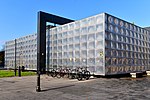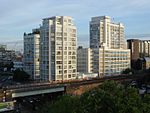Elephant & Castle tube station

Elephant & Castle is a London Underground station in the London Borough of Southwark in south London. It is on the Bank branch of the Northern line between Kennington and Borough stations, and is the southern terminus of the Bakerloo line, the next station being Lambeth North. The station is in both Travelcard Zones 1 and 2. The Northern line station was opened in 1890 by the City and South London Railway (C&SLR) while the Bakerloo line station was opened sixteen years later by the Baker Street and Waterloo Railway (BS&WR). There is out-of-station interchange with the nearby Elephant & Castle National Rail station.A girl born at the station in 1924 was the first baby to be born on the Underground network. The Bakerloo line building remains much as originally constructed and is a typical Leslie Green structure. The Northern line building was designed by Thomas Phillips Figgis, and was rebuilt several times until the current structure opened in 2003. Transport for London (TfL) is currently planning a major upgrade to the station. A Bakerloo line extension south to Camberwell was planned and approved in 1931 but construction never started. Similar proposals have been revived on several occasions; in 2014 TfL ran a consultation on an extension to Hayes and Beckenham Junction, which is still under consideration.
Excerpt from the Wikipedia article Elephant & Castle tube station (License: CC BY-SA 3.0, Authors, Images).Elephant & Castle tube station
Elephant and Castle, London Elephant and Castle (London Borough of Southwark)
Geographical coordinates (GPS) Address Nearby Places Show on map
Geographical coordinates (GPS)
| Latitude | Longitude |
|---|---|
| N 51.4944 ° | E -0.0997 ° |
Address
El Beauty Cosmetics
Elephant and Castle
SE1 6BN London, Elephant and Castle (London Borough of Southwark)
England, United Kingdom
Open on Google Maps








